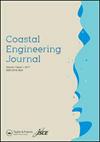Statistical modeling of undertow on a natural beach
IF 1.9
3区 工程技术
Q3 ENGINEERING, CIVIL
引用次数: 0
Abstract
ABSTRACT To better understand the physical mechanism of undertow, field observations were conducted during barred and planar beach states on the Hasaki coast in Japan. The two observation periods spanned 21 days from May 13 to June 2 in 2016, and 13 days from May 9 to May 22 in 2017, respectively. A horizontal acoustic Doppler current profiler was used to measure the undertow velocity and water level. The observed data were statistically analyzed to investigate the characteristics of the spatial and wave-energetic distributions of the undertow exceedance probability, PE . The results reveal that when the wave energy flux level was high, the undertow velocity increased, as did its PE . By contrast, the undertow PE during a low-wave-energy level decreased with greater water depths. Here, a Weibull distribution was applied to explain PE of the undertow. The Weibull parameters: scale and shape were estimated by the combination of normalized values of the wave energy flux, relative surf zone locations, and normalized water depths, and this generalized equation was considered a statistical model for estimating undertow PE . A comparison of the statistical model against the measurement demonstrates that the model accurately predicted the undertow PE with a small error.天然海滩暗流的统计模型
摘要为了更好地了解暗流的物理机制,在日本长崎海岸的条形和平面海滩状态下进行了实地观测。这两个观测期分别为2016年5月13日至6月2日的21天和2017年5月9日至5月22日的13天。利用水平声学多普勒海流剖面仪测量了潜流速度和水位。对观测数据进行统计分析,以研究潜流超越概率PE的空间和波浪能量分布特征。结果表明,当波浪能量通量水平高时,潜流速度增加,其PE也增加。相比之下,在低波浪能级期间,潜流PE随着水深的增加而减小。在这里,威布尔分布被应用来解释潜流的PE。威布尔参数:尺度和形状是通过波浪能量通量的归一化值、相对冲浪区位置和归一化水深的组合来估计的,并且该广义方程被认为是估计潜流PE的统计模型。统计模型与测量结果的比较表明,该模型准确地预测了潜流PE,误差较小。
本文章由计算机程序翻译,如有差异,请以英文原文为准。
求助全文
约1分钟内获得全文
求助全文
来源期刊

Coastal Engineering Journal
工程技术-工程:大洋
CiteScore
4.60
自引率
8.30%
发文量
0
审稿时长
7.5 months
期刊介绍:
Coastal Engineering Journal is a peer-reviewed medium for the publication of research achievements and engineering practices in the fields of coastal, harbor and offshore engineering. The CEJ editors welcome original papers and comprehensive reviews on waves and currents, sediment motion and morphodynamics, as well as on structures and facilities. Reports on conceptual developments and predictive methods of environmental processes are also published. Topics also include hard and soft technologies related to coastal zone development, shore protection, and prevention or mitigation of coastal disasters. The journal is intended to cover not only fundamental studies on analytical models, numerical computation and laboratory experiments, but also results of field measurements and case studies of real projects.
 求助内容:
求助内容: 应助结果提醒方式:
应助结果提醒方式:


